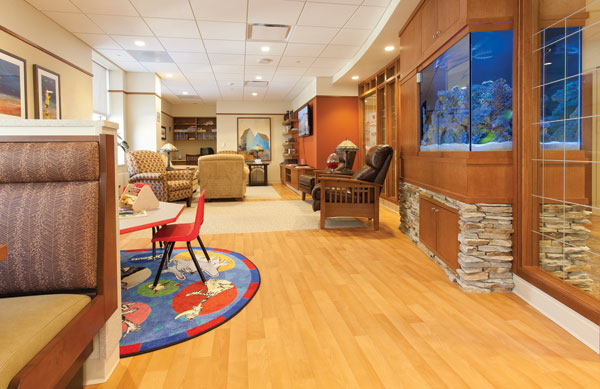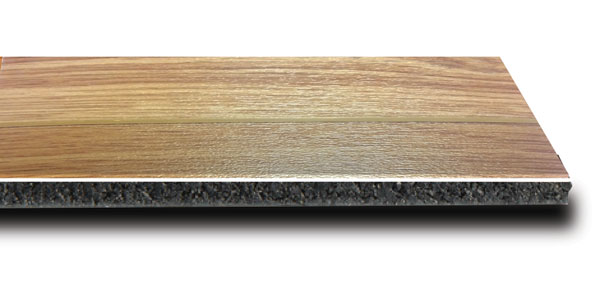New Trends in Resilient Flooring for Healthcare Environments
Evidence-Based Flooring
The 2004 landmark study “The Role of the Physical Environment in the Hospital of the 21st century,” sponsored by the Center for Health Design and the Robert Wood Johnson Foundation, reviewed more than 600 studies documenting the direct connection of the physical environment to patient healing and staff effectiveness.3 Since then, hundreds of other studies have confirmed the value of evidence-based design in healthcare settings. Noise, glare, poor air quality, and depressing and chaotic surroundings create stress that can be measured in real terms: heart rate, blood pressure, oxygen, and stress hormone levels in blood, time for wound healing, sleep quality, the need for pain drugs, the number of medical errors, and the frequency of HAIs can all be affected.
When good design and effective products reduce stressors, healing is promoted and the staff is more productive. Fortunately, there are strong financial incentives in the current healthcare system for making these improvements. As mentioned previously, Medicare payments are now linked to factors such as scores on patient satisfaction surveys. In 2015, 30 percent of the score on the Hospital Consumer Assessment of Healthcare Providers and Systems (HCAHPS) survey is based on how patients rate their care experience.4 Cleanliness and quiet are two major areas evaluated in the surveys. “Five Star” ratings on hospital comparisons are also being added.
Preventable injuries and infections during hospitalization are no longer reimbursed, so providers have higher liability risk. Recommendations from the Agency for Healthcare Research and Quality (AHRQ)5 identify prevention of patient falls, reduction of infection, and prevention of medication errors as areas of emphasis of evidence-based design to improve patient safety and quality of care. Use of specialized hospital flooring to prevent patient falls and reduce injury when falls do happen is specifically mentioned as a promising practice recommended for further research by this agency.
Flooring selected specifically for ergonomics and safety in healthcare settings can also improve staff productivity, safety, and retention. Caregiver fatigue, injury, and stress are tied to a higher risk of medication errors and patient infections. Safer workplaces translate to safer care. Studies have found higher patient satisfaction levels in hospitals where fewer nurses are dissatisfied or burned out.6
The retention of staff is becoming a critical issue in the healthcare industry, not only for trained nurses, but even for cleaning personnel and facility managers. High turnover is a problem for the delivery of care and also a major cost. According to the 2015 National Healthcare and RN Retention survey,7 the average cost of turnover for one bedside RN ranges from $44,380 to $63,400.
Evidence-based design covers a wide spectrum of factors, from workflow processes to room layout to information technology. In the following sections, we focus on four specific ways resilient flooring can contribute to a healthcare facility's mission while saving costs:
► Reducing noise
► Preventing injury
► Increasing cleanliness and controlling infection
► Creating a positive healing experience in every respect, from attractive surroundings to good indoor air quality

Photo courtesy of Ecore Commercial Flooring
St. Mary’s Hospital, Madison, Wisconsin. During renovation and the building of a new wing, carpet was removed throughout hallways and patient rooms, and replaced with 60,000 square feet of a no-wax sheet vinyl product providing the look of wood with an advanced lifetime no-wax finish. St. Mary’s combines many different specialized areas. Shown here, the Ronald MacDonald Family Room, designed as a place of respite for families of critically ill children in the nearby pediatric and neonatal intensive care units, has been designed to be especially quiet, home-like, and reassuring.
Acoustic Performance
“We are now witnessing a transformation in healthcare reimbursement to a 'pay for performance' model. Design and construction mandates related to acoustics can be expected to enhance performance through more accurate communication, increased speech privacy and HIPAA compliance, lowered staff stress levels, decreased medical errors, and limited patient sleep disruption. Together these should produce better clinical outcomes, reduce staff turnover rates, and provide advantages in the competitive marketplace, all of which carry positive cost implications.”
Validating Acoustic Guidelines for Healthcare Facilities
The Center for Health Design, 2010
Everyone intuitively understands that healing is more likely to take place in a calm, quiet atmosphere. But the high-tech, intense atmosphere of a hospital, filled with the noise of medical equipment, clattering carts, and echoing voices, can be the opposite of that. A Johns Hopkins study found that “regardless of country, type, or size of hospital, type of patient care unit, or time of day, there is a fairly narrow range of sound levels in hospitals, and all exceed recommended levels.”
A noisy, confusing hospital room can raise patients' blood pressure, heart rate, and muscle tension. Hormones released in response to stress can suppress the immune system, causing wounds to heal more slowly. A question on the HCAHPS patient satisfaction survey directly addresses “Quietness of Hospital Environment.”
As a result, hospitals are attempting to reduce the sources of noise on every front possible, e.g., limiting overhead paging and cell phone use, relocating ice makers and other 24-7 noise sources and wrapping ducts. The most direct way to improve the quiet surroundings in a patient's room is by soundproofing the ceilings and flooring.
Until very recently, “quiet” flooring meant carpet, the most absorptive flooring material. Although often used for that reason, carpet also has drawbacks in healthcare settings, such as difficulty cleaning and disinfecting, and adding to staff workload by making equipment more difficult to maneuver. Carpet can't be used in sterile environments like operating and treatment rooms. As a result, a major focus of resilient flooring research has been a technology that could provide the same acoustic properties as carpet but with the safety, ergonomic, and hygiene advantages of resilient flooring.
A recent study by The Acoustics Laboratory at the University of Hartford in Hartford, Connecticut,8 examined the acoustic performance of flooring products, using common sources of hospital noise. The study found that flooring composed of a no-wax sheet vinyl fused to a 90 percent post-consumer recycled rubber backing provided the same quiet as carpet.
A standard indicator of acoustic performance is absorptivity, a measure of how much sound is absorbed by the material. Resilient flooring can't match carpet's absorptivity, but researchers established that there are other ways to measure the amount of sound generated by the surface, and thus the actual overall quietness of a room.
The project aimed to quantify the effect that different flooring materials could have on hospital corridor noise: the footfall from staff and visitors and the rolling noises from medical carts and other equipment. Different tests were performed on each test material: an absorption test (ASTM C423), a tapping machine test, and a rolling cart test.
Five different products were tested:
► Commercial carpet tiles, rubber-backed
► Sheet vinyl with no rubber backing
► Sheet vinyl flooring surface fusion bonded to recycled rubber backing
► Standard vulcanized rubber flooring with no backing
► Vulcanized rubber fusion bonded to recycled rubber
The absorption test, as expected, found that carpet was the most absorptive material.
The test to measure the amount of sound generated by the surface used a standard tapping machine, the same equipment typically used when conducting field tests for Impact Insulation Class ratings. The results of this test confirmed that the vinyl surface fusion-bonded to the recycled rubber backing improved sound levels significantly, close to the levels generated by carpet.
In the rolling cart tests, a specially built mechanism repeatedly and consistently rolled a standard stainless steel hospital cart across the floor samples. Again, the rubber-backed sheet vinyl flooring produced almost the same amount of sound as the carpet (technically slightly less). (See chart.)
According to the study's final report, the combination of the no-wax sheet vinyl flooring with the recycled rubber backing “resulted in an overall sound power level reduction of 16 dB(A) during the tap test and an overall reduction of 5 dB(A) during the rolling cart test...nearly identical sound power spectra as the carpet.”

Image courtesy of Ecore Commercial Flooring
Safety First
Falls and fall injuries in hospitals are the most frequently reported adverse event among adults in the inpatient setting, and they account for substantial cost and liability to healthcare providers. Between 700,000 and 1 million patients suffer a fall in U.S. hospitals each year, according to the Agency for Healthcare Research and Quality.9 Between 30 and 51 percent of falls result in an injury. The cost to a hospital stay for a severe injury is an estimated $27,000 per event, and Medicare does not reimburse hospitals for any part of the extra care associated with an inpatient fall. Beyond the financial impact, the effect a serious fall has on the patient's quality of life after the event is often extremely damaging. Full recovery is rarely realized and a disability often results.
Slips, trips, and falls (STFs) also take a severe toll on hospital staff: They are the second most common cause of injury to staff (next to injuries such as sprains and strains from patient handling). According to OSHA, U.S. hospitals on average record about 6.8 work-related injuries and illnesses for every 100 full-time employees, a rate almost twice as high as private industry as a whole.10
An estimated 12 percent of nurses leaving their profession do so because of back injuries, and more than 50 percent complain of chronic back pain.11 Flooring that works to prevent falls also contributes to ergonomic comfort, reducing fatigue and preventing back pain.
A study of hospitals in England in 2010-201112 evaluated shock-absorbing flooring materials for its effect on fall-related injury severity, rates, and adverse events. The intervention group experienced less than half as many injurious falls as the control group.
Preventing falls involves process and patient factors as well as environmental ones, but safe flooring is an essential piece.13 Although the magnitude of the problem may seem to argue for padding all healthcare facilities with the softest, thickest floors available, flooring selection is more complicated than that. Flooring that is too soft can present a mobility problem for wheelchairs, those using walkers, and for others with difficulty walking, due to age, injury, or medication.
Soft floors also can create fatigue and injury among staff moving heavy equipment. Even low-nap carpet can require significantly greater effort to push heavy equipment or bariatric patients than a smooth, hard surface. Test results indicate that resilient flooring, such as recycled rubber or vinyl with a recycled rubber backing, can provide shock-absorbent flooring and ergonomic performance with effective push-pull properties.
The Center for Disease Control (CDC) study “Slip, Trip and Fall Prevention for Healthcare Workers” makes several recommendations, such as using slip-resistant safety flooring in areas exposed to water, grease, or particulate matter. Other CDC recommendations for safety include creating visual inserts for flooring level clues and replacing flooring that could be hazardous, in particular indented vinyl, tile with holes from equipment or furniture, and buckled or warped carpet.
Traditional vinyl flooring with foam backing often has compression problems, indentations, punctures, and visible seams. Rubber flooring, and new types of vinyl flooring with a recycled rubber backing, will indent but immediately recover and offer a range of surface textures for different needs. Both rubber flooring and safety flooring provide slip resistance, so there is less need for small mats that can be tripping hazards and trap bacteria.
Despite an industry-wide comprehensive effort to reduce falls, the number is still high and remains a critical concern for providers and insurers (and, of course, patients). When falls cannot be prevented, advanced flooring can still reduce the severity of the patient's injury. Testing on a resilient flooring product with a vinyl flooring surface fusion-bonded to a recycled rubber backing found that fall impact was reduced 16.9 percent (in accordance with DIN 18032).14

Image courtesy of Ecore Commercial Flooring
No-wax vinyl flooring fusion-bonded to recycled rubber backing for enhanced acoustic performance and reduction of fall injuries.









